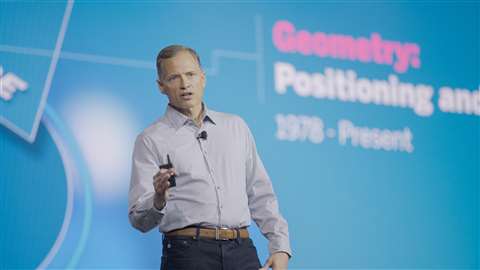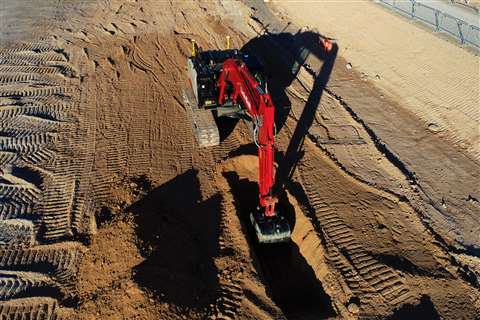Interview, Rob Painter, Trimble CEO: Tech can solve construction’s pain points
07 March 2023
Technology has the potential to help solve many of construction’s pain points, such as a lack of workers and the need to reduce emissions, Rob Painter, Trimble CEO, tells Andy Brown
The first time I meet Rob Painter, CEO of Trimble, it is alongside thousands of other people. Painter had appeared on the rather large main stand at the Trimble Dimensions event in Las Vegas, US, and was talking to the crowd of Trimble employees, customers and dealers. I’m sure I wasn’t the only one in the audience ‘meeting’ Painter for the first time – he has been with the company since 2006, but became CEO and President in 2020 and, due to the Covid-19 pandemic, this was the first time Dimensions had been held in four years.
Painter spoke well on stage, setting out his vision for the company before inviting Apple co-founder Steve Wozniak on stage for an enjoyably un-corporate conversation. Over 5,700 people attended Dimensions, making it the largest in Trimble’s history, as people embraced the opportunity to meet face-face. When I next met Painter for a relaxed conversation on a sofa later in the week, it was clear how much he was enjoying the event and the opportunities that technology can provide for construction.
Is technology a problem solver for construction?
“Look at the value proposition of what technology delivers. We have a labour shortage; our technology enables an inexperienced operator to become good and a good operator great,” he says.
“We can bring in a new set of workers into this industry, upskill workers. We literally have examples of people who’ve worked at a sandwich shop and become competent operators within a matter of weeks through the application of technology.”
 Rob Painter, Trimble (Photo: Trimble)
Rob Painter, Trimble (Photo: Trimble)
This lack of skilled workers, alongside supply chain issues and rising prices of materials is also providing those in the industry, whether it is contractors or project owners, extra incentive to look at how they can be more productive and cut costs. “You need technology more than ever in that inflationary environment to be able to do more with less,” says Painter.
Another reason for the Trimble CEO – and indeed all in construction – to be positive is the amount of money that is being invested into infrastructure around the world. It is estimated that US$79 trillion will be invested in infrastructure in the next 15 years.
In our conversation he mentions the HS2 rail link in the UK, the Grand Paris Project in France, and some ‘thought-leading’ infrastructure work in the Nordics, as well as President Biden’s infrastructure bill in the US. On this, Painter says, “It’s a generational opportunity to do something about our infrastructure. The size of it and the opportunity that comes along with it is a positive catalyst for the results that we have, and many in the industry are growing right now.”
The growth that Painter talks about has been substantial, with the CEO saying, “It’s been a record year for our business across the board. We’re seeing levels of growth that exceed anything we’ve had in the past. We have the mix of software and hardware, and I think that’s working. It provides the connection between the field and the office and the physical and the digital world.”
Accelerating the digital transformation of construction
At Dimensions there were several new product launches, including the Trimble Construction Cloud powered by Microsoft Azure, an industry cloud to streamline construction projects. The product has been designed to help accelerate the digital transformation of construction. One of the ways it will do this is by providing a ‘common data environment’ – having one centralised and common data environment that connects the office with site operations tools should mean that data is less fragmented and in fewer silos.
Painter tells me a key focus is, “making it easier for customers to access more of the technology. There’s also an aspect of moving more of the business models to recurring business models turning CapEx [capital expenses] into OpEx [operating expenses]. When you go through these turbulent times, it’s making it easier for a customer to adopt.”
Reducing costs from a large upfront payment to a monthly subscription charge and having all the data in one place should make it easier for customers. But what about the fact that data from different technology providers and OEMs doesn’t always talk to each other – how big a problem is this? “Oh, I think it’s a very large issue for the industry,” he replies.
“Our platform strategy is an open interoperable system. This is a gigantic industry, it’s a fragmented set of stakeholders that come together. Think about a subcontractor, or sub-subcontractors on a project. There’s no such thing as one ecosystem that’s going to do it all, or one company that’s going be able to meet every single need that’s in a project. That drives a mentality we have around being open and interoperable with the data.”
Construction data and automation
Trimble has spent around US$2 billion in recent years on research and development, and of that strikingly large figure the largest proportion has been invested in data and autonomy. The Trimble Construction Cloud powered by Microsoft Azure would be an example of investment in data, and Painter says that automation and autonomy is an area where the company has “stepped up investment” over the last couple of years.
Painter comments that Trimble sees, “autonomy as a progressive series of automation,” and in a way the company have been doing it for 20 years; it was just called machine control. So-called ‘full’ autonomy is a long way off, but automation can play a key role in increasing productivity.
 Technology is increasingly being used in construction
Technology is increasingly being used in construction
“The ability to add perception sensors and functional safety is really one of the gaps to be overcome as we move higher up the technology stack. We think about workflows that make sense to be further automated and to become autonomous. I don’t think everything should be automated; construction is generally a very bespoke operation, it’s not a mine, which is more of a closed loop, controlled environment,” he says.
“We don’t think that every site project is going to make sense to be done autonomously or every linear project to be done autonomously. We do think that they can become more automated. We do think they can become more productive, and we can take two person operations and make them a one-person operation.”
How can construction become more sustainable?
Being more productive ties into a major issue – arguably the major issue – facing construction: how to be more sustainable. In simple terms, the more efficient a project is then the fewer emissions are produced. As Painter neatly summaries, “The first place where you achieve sustainability benefits is through productivity.” He says that on a recent trip to Europe and Asia sustainability was in the top two priorities for “every customer.”
When talking about the potential of technology to play a key role in the drive for sustainability, Painter – who comes across as calm, measured and thoughtful – becomes excitable and animated. “It’s an exciting, inspiring time. How do you use your heartbeats in life? What do you want to work on, what do you want to do? Do you want to make a positive difference? With this work our ability to make a difference is enormous. That’s inspiring.”
It would be no surprise to anyone if at the next Trimble Dimensions, Painter, from the oversized stage, devotes a large section of time talking about sustainability and exactly what the technology sector is doing to help the giant and fractured construction industry reduce its emissions.
STAY CONNECTED



Receive the information you need when you need it through our world-leading magazines, newsletters and daily briefings.
CONNECT WITH THE TEAM








